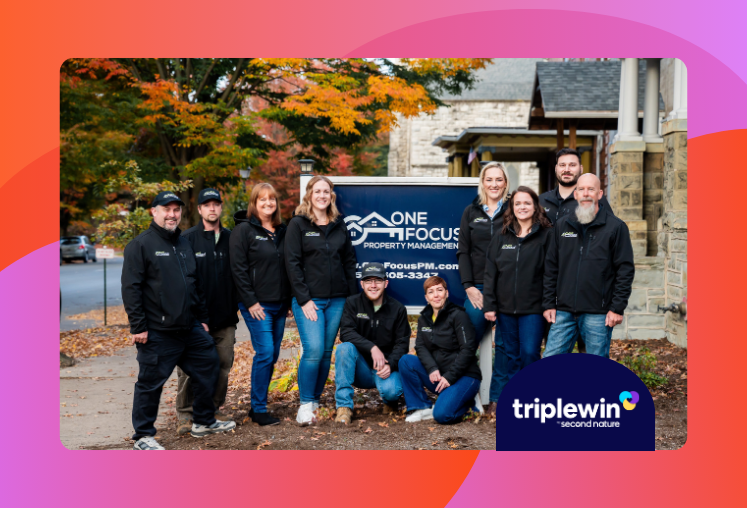Jennifer Ruelens is the broker/owner at One Focus Property Management, the largest property management company in North Central Pennsylvania. Jennifer has over twenty years of real estate experience, and 13 as broker/owner at One Focus. She also founded Hold It with PM Jen, a platform dedicated to helping investors grow wealth with the buy and hold real estate strategy. Jen is a Second Nature Triple Win Mentor.
When you’re growing a property management business, a universal challenge is figuring out what kinds of clients are the right fit. Bring on the wrong ones, and you burn through your team, churn accounts, and lose money. Bring on the right ones, and everything runs smoother—and becomes more profitable.
If only it were as simple as good versus bad. The truth is, even the best-fit clients usually require some leadership to get there.
One of the most valuable skills I’ve developed is knowing when to coach a client and when to cut them loose.
I’ve built a company that runs like a well-oiled machine, and I can’t afford to jam it up with the wrong clients or properties. If you put the wrong materials into a great machine, you don’t get great results. You get breakdowns. To me, clients and properties are the raw materials. And my job is to make sure we’re only putting in the right ones.
I evaluate two factors: trust and vision alignment.
Trust is the line in the sand
Clients must trust my team and our proven process. That’s not negotiable. Without trust, we can’t do our job.
I don’t expect blind faith. I lay out the plan, explain the process, and give data-backed pricing. If a client still can’t trust our expertise, especially when their buddy “who owns rentals” is their go-to instead, then that’s a no-go. If they don’t trust the vision I’ve outlined to stabilize and grow their investment, it’s better for both of us to walk away early.
Vision alignment matters
The other dealbreaker is a lack of vision alignment. I’m clear about the kinds of clients I want: long-term, buy-and-hold investors. If someone wants to flip properties or sell every few years, that’s a totally different mindset. It’s not what our machine is built for.
I also need clients to see their investment as a business that operates stabilized property. I define a stabilized property as one that “attracts and retains qualified tenants at market rent with no deferred maintenance.” That takes resources. If a client isn’t willing or able to fund that stabilization, they’re not aligned with our vision.
It’s not that every client buys into the full plan on day one. But it gives us a shared goal to start from. And in those early discussions, I’m trying to determine: are they optimizing the plan for their situation, or rejecting it altogether? That tells me whether they’re in or out, and how much coaching they need to be successful.
What if they’re not a perfect fit?
Most clients aren’t perfect right away. That’s okay. They don’t need to be. They just need to bring the right ingredients, and be open to the process. That’s where coaching comes in.
I front-load expectations. Before a client even has a chance to get emotional about something, I’ve already addressed it. I explain their role, the process, what they can expect from us, and what we’ll expect from them. If you wait for a client to raise a concern, you’ve already ceded authority. I call this showing leadership in your advisory role.
Set the tone early. Show leadership. Be the coach.
Managing emotions without becoming a therapist
It’s totally normal for clients to be emotionally attached to a property—especially if they’ve lived in it or inherited it. But property management isn’t therapy.
I don’t try to fix their emotional hang-ups. I do try to relate. “I get it. My grandfather built a house too.” That simple moment of connection might help them take the next step toward being a landlord. But if they can’t grow into the investor mindset? That’s a cut.
Now, if you also do real estate sales, maybe a sentimental landlord is still a potential listing for you. But I don’t sell houses, and I’m not interested in working with someone who’s just emotionally attached to a rental.
The team comes first
My emphasis on trust and vision alignment isn’t just about me. It’s about protecting my team.
I could probably tolerate working with just about anyone. But I’ve seen how the wrong client damages team morale. And at this point in my business, I have the confidence to defend my people and hold clients to our standards. Every time I defend my team, I show them they can trust my leadership. That builds loyalty.
Looking ahead: a growing need for coaching
Now is the time to sharpen your “coach or cut” instincts. The wave of new clients is coming—and they won’t all be investor pros. With the generational wealth transfer in full swing, we’re seeing more accidental landlords inheriting properties. Many of them are emotionally attached and financially unprepared. They’ll need coaching.
At the same time, high interest rates mean fewer owners have cash on hand for repairs or improvements. Deferred maintenance is about to become your new reality.
Coaching is already part of the job. But going forward, it will become essential to how we lead, protect our teams, and deliver results.
So get good at reading the signs. Don’t be afraid to decide: coach or cut. Your team and growth depend on it.
Topics:




